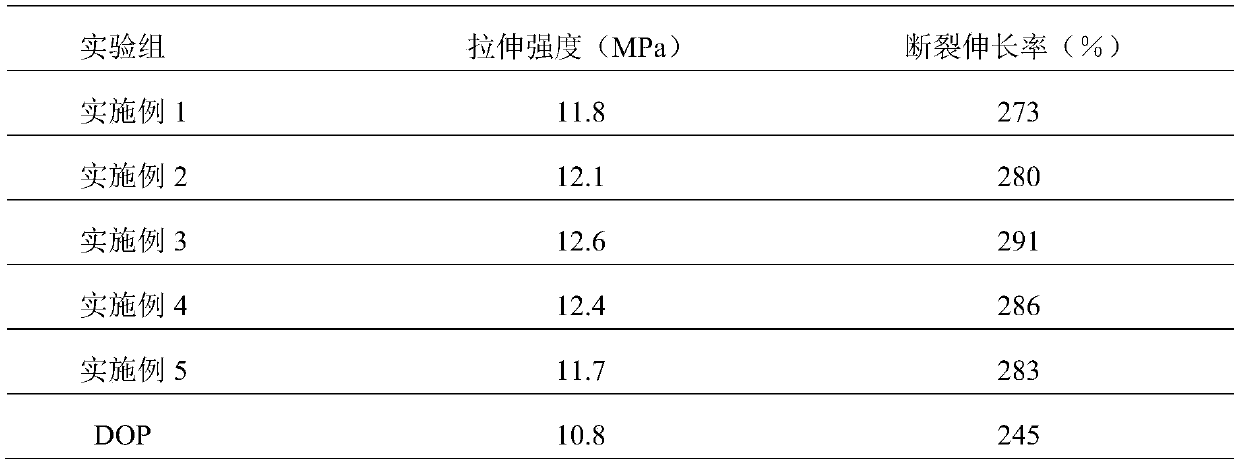Synthetic method of ethanediol polyester plasticizer
A technology of polyester plasticizer and synthesis method, which is applied in the field of synthesis of ethylene glycol polyester plasticizer, can solve the problems affecting the actual application performance of products and the decrease of the softness of PVC materials, and achieve good antistatic effect and product Excellent appearance and low acid value
- Summary
- Abstract
- Description
- Claims
- Application Information
AI Technical Summary
Problems solved by technology
Method used
Image
Examples
Embodiment 1
[0032] Weigh 2KG of ethylene glycol and 4.26KG of 2-methylsuccinic acid into a 10L autoclave. Heating was started under the protection of nitrogen, the temperature in the kettle rose to 135° C., and stirring was started. Under the protection of nitrogen, 1.5 g of tetraisopropyl titanate was added, and the temperature was continuously raised to carry out the esterification reaction. When the pressure in the kettle reaches 11KG and the temperature in the kettle is 184-186°C, start to drain water until the pressure in the kettle drops to 0 (or nitrogen flow pressure), and it takes 45 minutes. The temperature was slowly raised to 195°C, and the water was drained under normal pressure for 10 minutes under the protection of nitrogen flow until no distillate was discharged.
[0033] Under the protection of nitrogen, the temperature in the kettle rose to 215°C. Turn on the vacuum device, depressurize and drain water under the condition of vacuum degree of 700Pa, further polycondensa...
Embodiment 2
[0035]Weigh 1.2KG of diethylene glycol, 2.2KG of tetraethylene glycol and 3.0KG of 2-methylsuccinic acid into a 10L autoclave. Heating was started under the protection of nitrogen, the temperature in the kettle rose to 135° C., and stirring was started. Under the protection of nitrogen, 1.5 g of tetraisopropyl titanate was added, and the temperature was continuously raised to carry out the esterification reaction. When the pressure in the kettle reaches 11KG and the temperature in the kettle is 184-186°C, start to drain water until the pressure in the kettle drops to 0 (or nitrogen flow pressure), and it takes 45 minutes. The temperature was slowly raised to 195°C, and the water was drained under normal pressure for 10 minutes under the protection of nitrogen flow until no distillate was discharged.
[0036] Under the protection of nitrogen, the temperature in the kettle rose to 215°C. Turn on the vacuum device, depressurize and drain water at a vacuum degree of 700Pa, furth...
Embodiment 3
[0038] Weigh 3.6KG of triethylene glycol and 3.17KG of 2-methylsuccinic acid into a 10L autoclave. Heating was started under the protection of nitrogen, the temperature in the kettle rose to 135° C., and stirring was started. Under the protection of nitrogen, 1.5 g of tetraisopropyl titanate was added, and the temperature was continuously raised to carry out the esterification reaction. When the pressure in the kettle reaches 11KG and the temperature in the kettle is 184-186°C, start to drain water until the pressure in the kettle drops to 0 (or nitrogen flow pressure), and it takes 45 minutes. The temperature was slowly raised to 195°C, and the water was drained under normal pressure for 10 minutes under the protection of nitrogen flow until no distillate was discharged.
[0039] Under the protection of nitrogen, the temperature in the kettle rose to 215°C. Turn on the vacuum device, depressurize and drain water at a vacuum degree of 700Pa, further polycondensate for 30 min...
PUM
| Property | Measurement | Unit |
|---|---|---|
| thickness | aaaaa | aaaaa |
| elongation at break | aaaaa | aaaaa |
| degree of polymerization | aaaaa | aaaaa |
Abstract
Description
Claims
Application Information
 Login to View More
Login to View More - R&D
- Intellectual Property
- Life Sciences
- Materials
- Tech Scout
- Unparalleled Data Quality
- Higher Quality Content
- 60% Fewer Hallucinations
Browse by: Latest US Patents, China's latest patents, Technical Efficacy Thesaurus, Application Domain, Technology Topic, Popular Technical Reports.
© 2025 PatSnap. All rights reserved.Legal|Privacy policy|Modern Slavery Act Transparency Statement|Sitemap|About US| Contact US: help@patsnap.com



